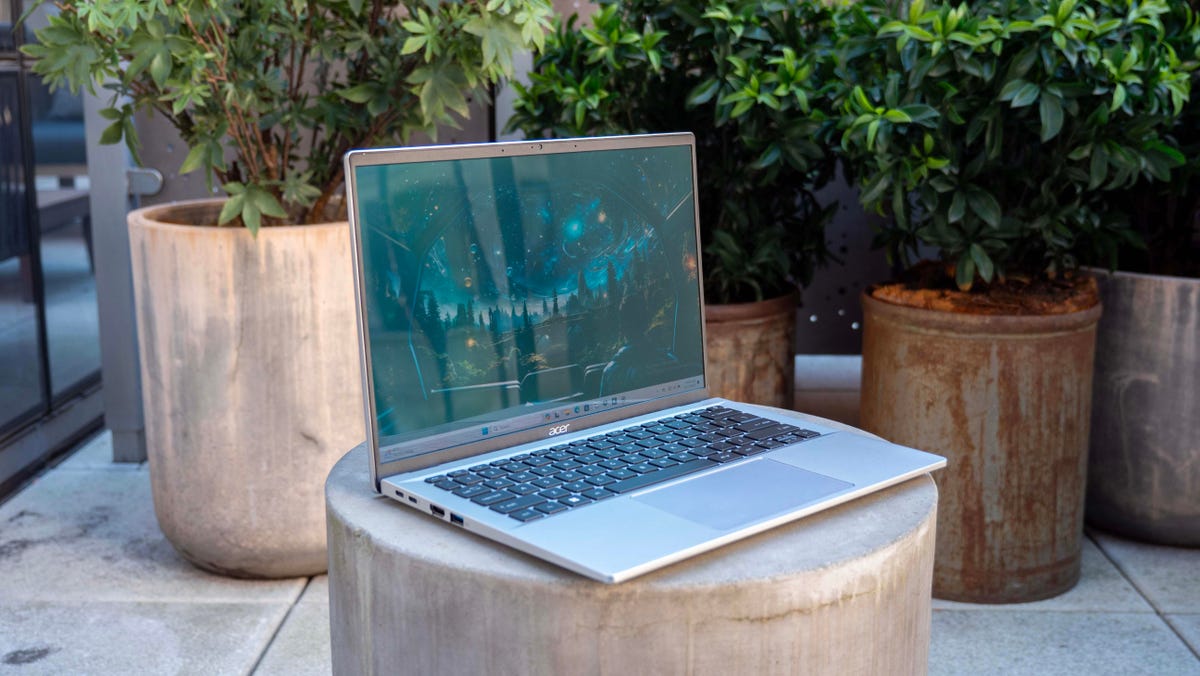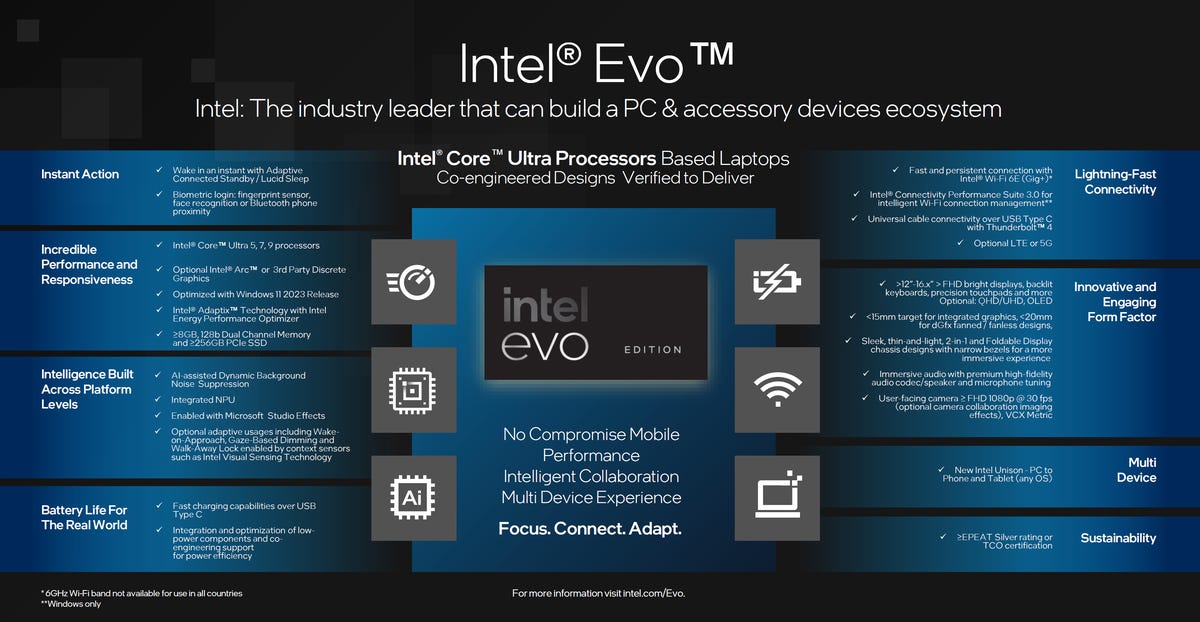Intel’s latest generation of its Meteor Lake mobile chip architecture has been trundling down the road for so long that the announcement of the actual chips has been somewhat anticlimactic — especially since it doesn’t offer much reason for most consumers to use AI. (The goal is still selling it to software makers.)
My colleague Stephen Shankland and I have already covered the new low-power E-core, which is intended to run light sustained workloads (think video streaming) without hitting the battery as much as the regular old E-cores. We understand why this AI push is so important to Intel’s business. We know how Intel rebranded the Meteor Lake chips as Core Ultra. The chips are made using the company’s latest Intel 4 process. And Intel is last to the announcement party; AMD and Qualcomm have already planted their flags.
While the new chips have a small, two-core neural processing unit, or NPU, for AI acceleration, Intel’s AI Boost uses the CPU and GPU as well, depending upon the type of workload: The CPU is used when speed is needed and the GPU for help with generative AI workloads.
Read more: AI Helps Chipmakers Design the Very Processors That Speed Up AI
That’s why you’ll hear Intel and AMD talk about AI performance metrics — TOPS, sometimes referred to as TeraOPS, or trillion operations per second — for the combined system rather than just the NPU. For the Ultra 7 165H chip, you get roughly up to 34 TOPS with 11 TOPS for the NPU, 18 TOPS for the GPU and the rest for the CPU.
In comparison, AMD says its XDNA in the new Ryzen 8040 series performs at 39 TOPS, attributing 16 TOPS to the NPU and the remainder to the CPU and GPU. So even though NPUs are getting big buzz, they actually only carry a small part of the AI workload in these chips.
But these numbers also only paint a part of the performance picture for AI because there’s no “typical” AI workload, and at the moment, no consistent methods of implementing it — there’s still a lot of shakin’ going on in the software.
The Ultra chips inside
Today’s chips will be shipping in a lot of laptops by the end of the month, with preorders starting today. Their specs and positioning will make way for a different class of chip and laptop announcements at CES.
The usual cavalcade of companies are on board, so be ready for new and refreshed laptops from Intel’s partners, including the Acer Swift Go 14 (starting at $800 with a Core Ultra 5 and up to an Ultra 7) and the Predator Triton Neo 16 gaming laptop (with up to a Core Ultra 9 and GeForce RTX 4070, starting at $1,500). The top end of each line of the Ultra 9, Ultra 7 and Ultra 5 will ship a little later: Laptops with those chips should be available around March.

Intel continues its recent tradition of planting the H series flag in the middle of the road. It’s for when you need a little more power than you can get with the U series, which is built for the thinnest designs. H series chips are for systems where you want discrete-ish graphics and are willing to trade off power for a little more weight.
In order to qualify for Evo Edition branding — Intel’s don’t-bother-thinking-before-you-buy imprimatur for systems that use lots of the latest technologies — the systems will need to incorporate a Core Ultra.
Intel has been pretty low-key about its battery-life discussions, but the gist seems to be that it’s seeing up to a 25% increase. More battery life is always better, but that probably still leaves Intel-based laptops lagging MacBooks. Sigh.


One of the more compelling reasons to look for the new Core Ultra H or U series in your next laptop is the updated integrated graphics engine. The H series will incorporate Intel’s latest generation of Arc graphics, which finally brings the company’s integrated graphics into the 2020s, and means it might be able to take on AMD’s Radeon integrated graphics. (They’ll hopefully get faster thanks to the new 700M used in the just-announced Ryzen 8040 series laptop processors.)
Both the Arc graphics and the updated (but even more generically dubbed) “Intel Graphics” based on the next generation of Xe GPU cores, LPG, improve support for the Endurance Gaming mode. That’s Intel’s way of making you think the performance is better by using AI-augmented upscaling (XeSS, similar to Nvidia’s DLSS) to reduce the amount of power gaming takes at the expense of quality. It upscales starting at a particularly low resolution.
The new iGPUs also add support for DirectX 12 Ultimate, which means they support modern technologies like raytracing and mesh shaders — in other words, higher-quality graphics. The Xe cores also have a faster version of its DP4A engine, which helps with GPU acceleration of AI for certain types of calculation.
Mobile H- and U-series processors
| P-Cores/ max boost (GHz) | E-cores/ max boost (GHz) | LP E-cores | Total threads | Power class(base/boost watts) | GPU | GPU cores/ max boost (GHz) | Available | |
|---|---|---|---|---|---|---|---|---|
| Core Ultra 9 185H | 6/5.1 | 8/3.8 | 2 | 22 | 45/115 | Arc Xe | 8/2.35 | Q1 2024 |
| Core Ultra 7 165U | 2/4.9 | 8/3.8 | 2 | 14 | 15-57 | Xe | 4/2.00 | Q4 2023 |
| Core Ultra 7 165H | 6/5.0 | 8/3.8 | 2 | 22 | 28/64-115 | Arc Xe | 8/2.30 | Q4 2023 |
| Core Ultra 7 164U | 2/4.8 | 8/3.8 | 2 | 14 | 9/30 | Xe | 4/1.80 | Q1 2024 |
| Core Ultra 7 155U | 2/4.8 | 8/3.8 | 2 | 14 | 15-57 | Xe | 4/1.95 | Q4 2023 |
| Core Ultra 7 155H | 6/5.0 | 8/3.8 | 2 | 22 | 28/64-115 | Arc Xe | 8/2.25 | Q4 2023 |
| Core Ultra 5 135U | 2/4.4 | 8/3.6 | 2 | 14 | 15-57 | Xe | 4/1.90 | Q4 2023 |
| Core Ultra 5 135H | 4/4.6 | 8/2.2 | 2 | 18 | 28/64-115 | Arc Xe | 7/2.20 | Q4 2023 |
| Core Ultra 5 134U | 2/4.4 | 8/3.6 | 2 | 14 | 9/30 | Xe | 4/1.75 | Q1 2024 |
| Core Ultra 5 125U | 2/4.3 | 8/3.6 | 2 | 14 | 15-57 | Xe | 4/1.85 | Q4 2023 |
| Core Ultra 5 125H | 4/4.5 | 8/2.2 | 2 | 18 | 28/64-115 | Arc Xe | 7/2.20 | Q4 2023 |
The more powerful Arc GPUs require systems with a minimum of 16GB memory, which may put a lower limit on prices. Intel makes a big deal about how much better the Arc performance is than its older GPU, but really, there’s no way it couldn’t improve on the previous generation.
Every generation brings new related capabilities. Not all laptops will support all the new features in this case, but they change the specs you should be looking for.
Core Ultra laptops should have Wi-Fi 6E support, for instance. That’s integrated into the silicon, but only a handful will offer Wi-Fi 7 at launch. Wi-Fi 7 is brand new, but it promises more stability and bandwidth, plus less channel crowding, using the 5 and 6MHz bands typical of 6E. I’ve had some problems with 6E signal detection, but when it works it’s faster than Wi-Fi 6/5, so I’m looking forward to Wi-Fi 7.
The new networking also includes support for Bluetooth 5.4, which has some new features over 5.3 — the most notable is bidirectional communications, which gives Bluetooth the potential for more sophisticated device-to-device interactions.
We’re already working on our review of an Acer Swift Go, so we’ll be back with more about how this year’s options compare to their predecessors.
